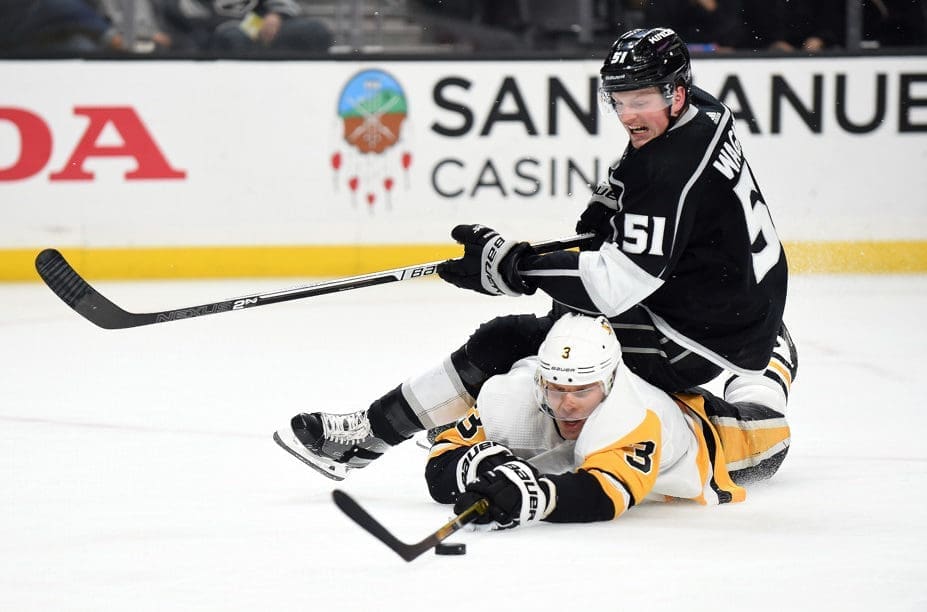Penguins
Problems of a Flat Salary Cap, Penguins Veterans on the Bubble

The 2020-21 NHL salary cap won’t be going up. Not even with a Briggs truck full of Benjamins from Seattle and a miracle from above, the NHL salary cap will not rise as expected next season. More than a few teams lined up future payrolls based on presumed growth, so more than a few clubs which live near the cap ceiling, including the Pittsburgh Penguins, are going to be in trouble.
Big trouble.
By letter of the CBA agreement, the cap could significantly drop. Last week, Pierre McGuire told our friends at 93-7 the Fan the cap could drop by 25-40%. Even if the NHL and NHLPA agree to rework the details, a salary cap decline is possible.
In fact, if the coronavirus pause causes catastrophic losses, the salary cap could be stagnant for years to come as the balance sheets are balanced.
According to CapFriendly.com, the Penguins have about $68 million allocated to 15 players. If the salary cap remains the same, they’ll have about $13 million for seven, maybe eight players. The Penguins often rolled with only 22 players, rather than the maximum 23 this season, and last.
McGuire also told the Fan he felt the Penguins would effort to keep both goalies, Matt Murray and Tristan Jarry, who will both be RFAs. Keeping both would be ideal, but a restrictive balance sheet makes that unlikely.
Making the prospect of keeping both goalies even more improbable, the Penguins have goalie Casey DeSmith stashed in the AHL. The NHL buried cap recapture is based on the minimum NHL salary + $375,000. Last season, DeSmith cost the Penguins $175,000. The Penguins could lose even more of their precious space if the NHL and NHLPA agree to lower the minimum salary as part of revenue and cap restructuring.
A couple hundred thousand bucks are the least of the Penguins worries. To ice the best team, the Pittsburgh Penguins will put veteran contracts on the chopping block, even before they squeeze RFAs Jared McCann and their goalie of choice.
NHL teams will likely receive at least one compliance buyout if the cap declines, but a flat cap probably won’t give teams that luxury of a consequence-free mulligan.
Salary Cap Math
The Pittsburgh Penguins will need to dish the coins to McCann, a starting goalie, a right-side defenseman, a right winger capable of top-six duty, and forward depth.
Let’s earmark $7 million, conservatively, for McCann and Murray. Under normal circumstances, that number should be $8 million or more. However, the events will force the Penguins to play hardball as they did last summer with Marcus Pettersson when they forced the defender to sign a low-ball qualifying offer instead of a long-term contract.
That leaves the Penguins only six million to fill five spots. Now, we’ll add DeSmith as the backup goalie, and the Penguins are down to about $4.7 million for four roster spots, including a right-winger and right-side defenseman.
Adding two depth forwards, even at minimum salaries, means the Penguins piggy bank will have about $3 for an RHD and an RW; keeping at least $800,000 for space under the ceiling for emergencies, just over $2 million isn’t enough to fill both spots with anything more than journeymen.
The Penguins will need to make sacrifices.
Veterans on the Bubble
Let’s begin with Jack Johnson. No matter what happens, there is a segment of the fanbase that demands he be sacrificed (seriously, let some light in). Should the Penguins buyout Johnson’s $3.25 AAV, which has three more years, they would save about $2.2 million for the next two years, $1.3 million in the third year.
That’s one way to look at it.
The other way to look at buying out Johnson is six years of lost salary cap space becaus in three years the Penguins would be docked over $900,000 per year for an additional three years. In real-world terms, the Penguins couldn’t spend more than $2 million on his replacement for the next six years, or they would actually spend MORE money.
Yeah, no.
The Pittsburgh Penguins failed to trade Johnson at the beginning of this season, and a deal would cost the Penguins an asset, or they would accept salary in return, and the savings after factoring replacement cost just aren’t significant. The Penguins don’t have a lot of assets to burn.
Expect Johnson to be back. And given his level of play this season (and most of last season, too), that’s not a bad thing.
However, for real savings, the Penguins GM Jim Rutherford will need to look elsewhere.
Center Nick Bjugstad, with his $4.1 million cap hit, is probably a goner. The Penguins will be able to trade Bjugstad, so a buyout is unneeded, but given the coming crunch for many teams, they may have to take a salary in return.
There are savings to be had here. Bjugstad seems a sure bet to have a new address next season.
But $4 million is the bare minimum the Penguins need to save to add a competent RW and RHD.
We’ve run the numbers on Patric Hornqvist, too. Shedding Hornqvist’s $5.3 million AAV would be a quick fix to the salary cap crunch, but replacing 20 goals scored within a few feet of the net would prove difficult, if not impossible. Replacing Hornqvist’s energy and locker room presence would also be next to impossible.
Unless the Pittsburgh Penguins have the chance to grab a high-value target, they can keep Hornqvist.
Defenseman Marcus Pettersson is a dark horse in this conversation. He would certainly have some value on the trade market. His new $4 million salary and potential may tempt other GMs if Rutherford explicitly finds himself in a pickle.
For now, the entire league is in a pickle.












